Critical Evaluation Report: Assessing a Healthcare Research Study
VerifiedAdded on 2022/12/15
|8
|2834
|298
Report
AI Summary
This report presents a critical evaluation of a quantitative research article published in the Annals of Emergency Medicine, focusing on the effectiveness of skin glue in reducing the failure rate of peripheral intravenous catheters (PIVCs) in the emergency department (ED). The report analyzes the article's introduction, title, abstract, study structure, sample, data collection methods, data analysis, and findings. It highlights the study's strengths, such as its alignment of the title with the content, the use of expert authors, and the consistent findings regarding the decreased failure rate with skin glue application. The evaluation also identifies limitations, including the non-blinded study design, lack of detailed data on patient characteristics, and the absence of a standardized protocol for outcome measurements. Furthermore, the report discusses the relevance of the research to nursing practice, emphasizing the importance of evidence-based practice, patient comfort, and cost-effectiveness. The author concludes that the study provides valuable evidence for healthcare providers, supporting the use of skin glue to improve patient outcomes and reduce healthcare costs.
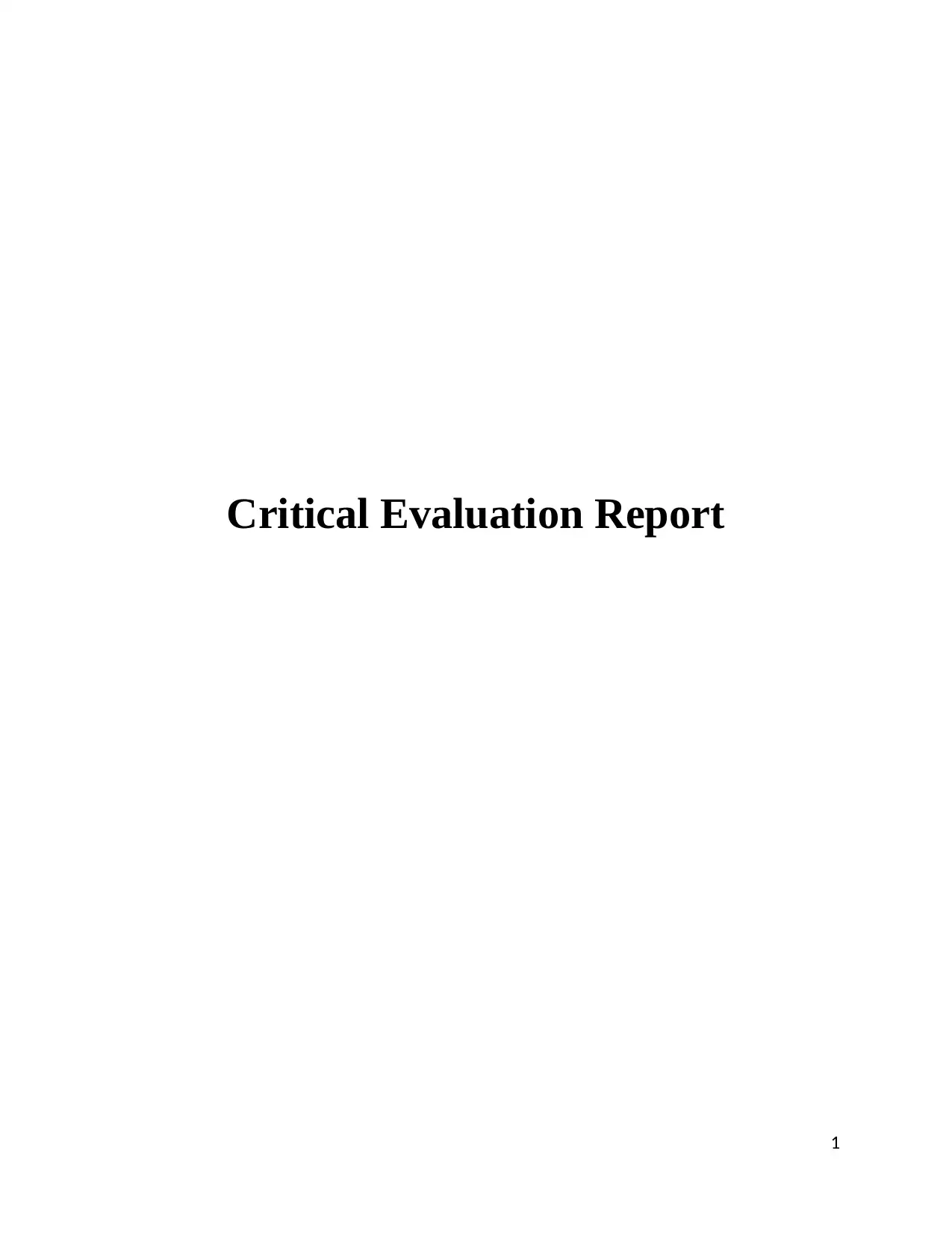
Critical Evaluation Report
1
1
Paraphrase This Document
Need a fresh take? Get an instant paraphrase of this document with our AI Paraphraser
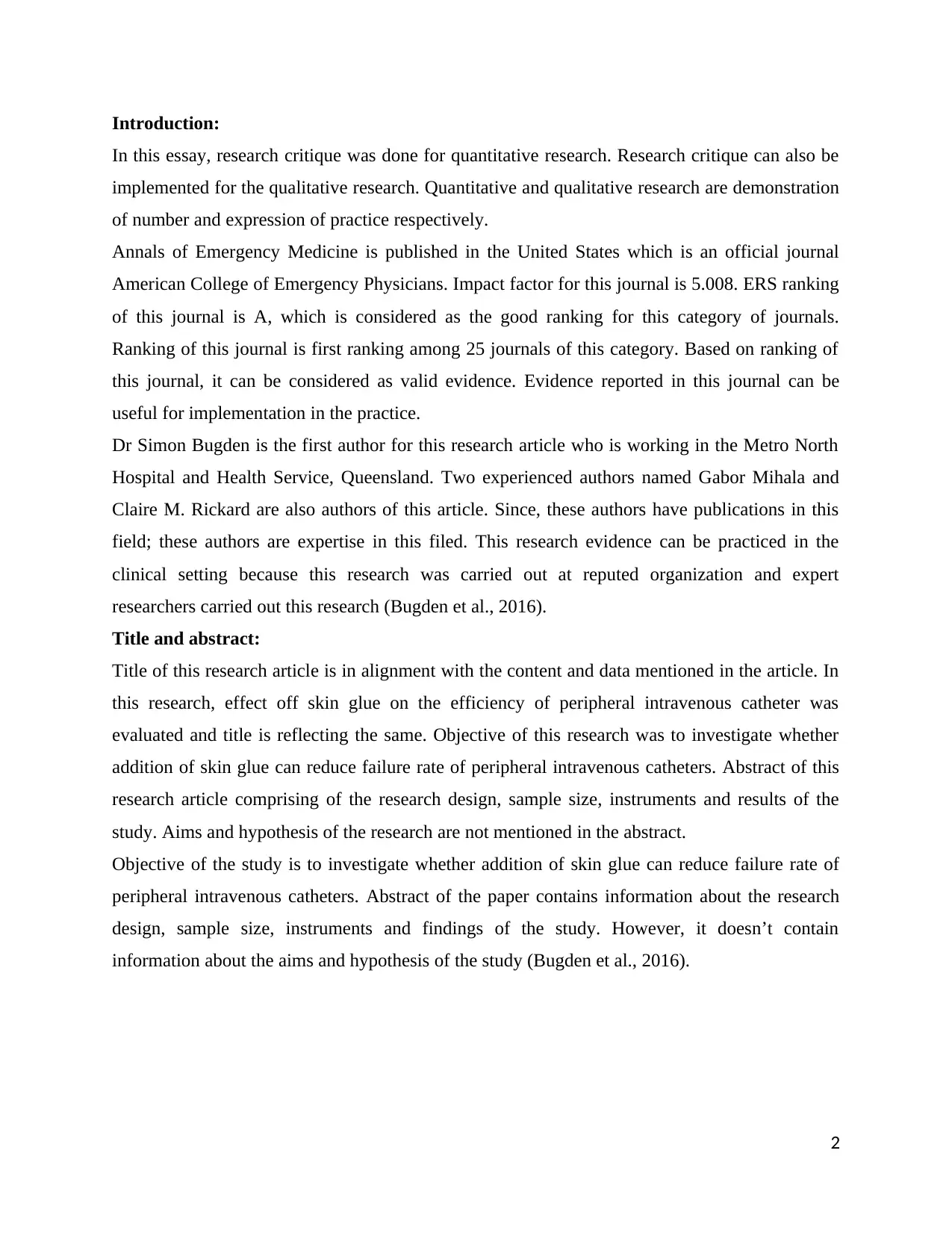
Introduction:
In this essay, research critique was done for quantitative research. Research critique can also be
implemented for the qualitative research. Quantitative and qualitative research are demonstration
of number and expression of practice respectively.
Annals of Emergency Medicine is published in the United States which is an official journal
American College of Emergency Physicians. Impact factor for this journal is 5.008. ERS ranking
of this journal is A, which is considered as the good ranking for this category of journals.
Ranking of this journal is first ranking among 25 journals of this category. Based on ranking of
this journal, it can be considered as valid evidence. Evidence reported in this journal can be
useful for implementation in the practice.
Dr Simon Bugden is the first author for this research article who is working in the Metro North
Hospital and Health Service, Queensland. Two experienced authors named Gabor Mihala and
Claire M. Rickard are also authors of this article. Since, these authors have publications in this
field; these authors are expertise in this filed. This research evidence can be practiced in the
clinical setting because this research was carried out at reputed organization and expert
researchers carried out this research (Bugden et al., 2016).
Title and abstract:
Title of this research article is in alignment with the content and data mentioned in the article. In
this research, effect off skin glue on the efficiency of peripheral intravenous catheter was
evaluated and title is reflecting the same. Objective of this research was to investigate whether
addition of skin glue can reduce failure rate of peripheral intravenous catheters. Abstract of this
research article comprising of the research design, sample size, instruments and results of the
study. Aims and hypothesis of the research are not mentioned in the abstract.
Objective of the study is to investigate whether addition of skin glue can reduce failure rate of
peripheral intravenous catheters. Abstract of the paper contains information about the research
design, sample size, instruments and findings of the study. However, it doesn’t contain
information about the aims and hypothesis of the study (Bugden et al., 2016).
2
In this essay, research critique was done for quantitative research. Research critique can also be
implemented for the qualitative research. Quantitative and qualitative research are demonstration
of number and expression of practice respectively.
Annals of Emergency Medicine is published in the United States which is an official journal
American College of Emergency Physicians. Impact factor for this journal is 5.008. ERS ranking
of this journal is A, which is considered as the good ranking for this category of journals.
Ranking of this journal is first ranking among 25 journals of this category. Based on ranking of
this journal, it can be considered as valid evidence. Evidence reported in this journal can be
useful for implementation in the practice.
Dr Simon Bugden is the first author for this research article who is working in the Metro North
Hospital and Health Service, Queensland. Two experienced authors named Gabor Mihala and
Claire M. Rickard are also authors of this article. Since, these authors have publications in this
field; these authors are expertise in this filed. This research evidence can be practiced in the
clinical setting because this research was carried out at reputed organization and expert
researchers carried out this research (Bugden et al., 2016).
Title and abstract:
Title of this research article is in alignment with the content and data mentioned in the article. In
this research, effect off skin glue on the efficiency of peripheral intravenous catheter was
evaluated and title is reflecting the same. Objective of this research was to investigate whether
addition of skin glue can reduce failure rate of peripheral intravenous catheters. Abstract of this
research article comprising of the research design, sample size, instruments and results of the
study. Aims and hypothesis of the research are not mentioned in the abstract.
Objective of the study is to investigate whether addition of skin glue can reduce failure rate of
peripheral intravenous catheters. Abstract of the paper contains information about the research
design, sample size, instruments and findings of the study. However, it doesn’t contain
information about the aims and hypothesis of the study (Bugden et al., 2016).
2
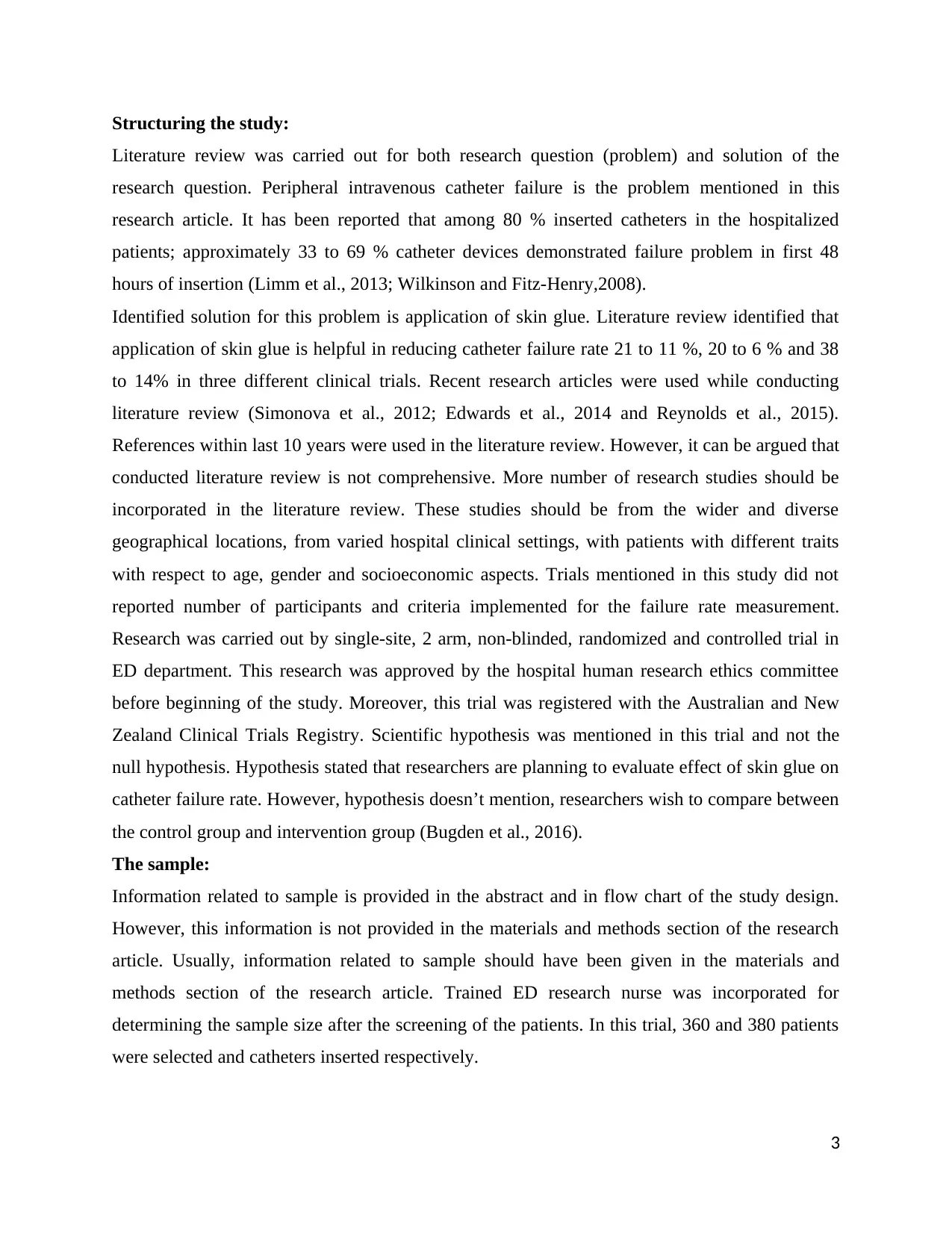
Structuring the study:
Literature review was carried out for both research question (problem) and solution of the
research question. Peripheral intravenous catheter failure is the problem mentioned in this
research article. It has been reported that among 80 % inserted catheters in the hospitalized
patients; approximately 33 to 69 % catheter devices demonstrated failure problem in first 48
hours of insertion (Limm et al., 2013; Wilkinson and Fitz-Henry,2008).
Identified solution for this problem is application of skin glue. Literature review identified that
application of skin glue is helpful in reducing catheter failure rate 21 to 11 %, 20 to 6 % and 38
to 14% in three different clinical trials. Recent research articles were used while conducting
literature review (Simonova et al., 2012; Edwards et al., 2014 and Reynolds et al., 2015).
References within last 10 years were used in the literature review. However, it can be argued that
conducted literature review is not comprehensive. More number of research studies should be
incorporated in the literature review. These studies should be from the wider and diverse
geographical locations, from varied hospital clinical settings, with patients with different traits
with respect to age, gender and socioeconomic aspects. Trials mentioned in this study did not
reported number of participants and criteria implemented for the failure rate measurement.
Research was carried out by single-site, 2 arm, non-blinded, randomized and controlled trial in
ED department. This research was approved by the hospital human research ethics committee
before beginning of the study. Moreover, this trial was registered with the Australian and New
Zealand Clinical Trials Registry. Scientific hypothesis was mentioned in this trial and not the
null hypothesis. Hypothesis stated that researchers are planning to evaluate effect of skin glue on
catheter failure rate. However, hypothesis doesn’t mention, researchers wish to compare between
the control group and intervention group (Bugden et al., 2016).
The sample:
Information related to sample is provided in the abstract and in flow chart of the study design.
However, this information is not provided in the materials and methods section of the research
article. Usually, information related to sample should have been given in the materials and
methods section of the research article. Trained ED research nurse was incorporated for
determining the sample size after the screening of the patients. In this trial, 360 and 380 patients
were selected and catheters inserted respectively.
3
Literature review was carried out for both research question (problem) and solution of the
research question. Peripheral intravenous catheter failure is the problem mentioned in this
research article. It has been reported that among 80 % inserted catheters in the hospitalized
patients; approximately 33 to 69 % catheter devices demonstrated failure problem in first 48
hours of insertion (Limm et al., 2013; Wilkinson and Fitz-Henry,2008).
Identified solution for this problem is application of skin glue. Literature review identified that
application of skin glue is helpful in reducing catheter failure rate 21 to 11 %, 20 to 6 % and 38
to 14% in three different clinical trials. Recent research articles were used while conducting
literature review (Simonova et al., 2012; Edwards et al., 2014 and Reynolds et al., 2015).
References within last 10 years were used in the literature review. However, it can be argued that
conducted literature review is not comprehensive. More number of research studies should be
incorporated in the literature review. These studies should be from the wider and diverse
geographical locations, from varied hospital clinical settings, with patients with different traits
with respect to age, gender and socioeconomic aspects. Trials mentioned in this study did not
reported number of participants and criteria implemented for the failure rate measurement.
Research was carried out by single-site, 2 arm, non-blinded, randomized and controlled trial in
ED department. This research was approved by the hospital human research ethics committee
before beginning of the study. Moreover, this trial was registered with the Australian and New
Zealand Clinical Trials Registry. Scientific hypothesis was mentioned in this trial and not the
null hypothesis. Hypothesis stated that researchers are planning to evaluate effect of skin glue on
catheter failure rate. However, hypothesis doesn’t mention, researchers wish to compare between
the control group and intervention group (Bugden et al., 2016).
The sample:
Information related to sample is provided in the abstract and in flow chart of the study design.
However, this information is not provided in the materials and methods section of the research
article. Usually, information related to sample should have been given in the materials and
methods section of the research article. Trained ED research nurse was incorporated for
determining the sample size after the screening of the patients. In this trial, 360 and 380 patients
were selected and catheters inserted respectively.
3
⊘ This is a preview!⊘
Do you want full access?
Subscribe today to unlock all pages.

Trusted by 1+ million students worldwide
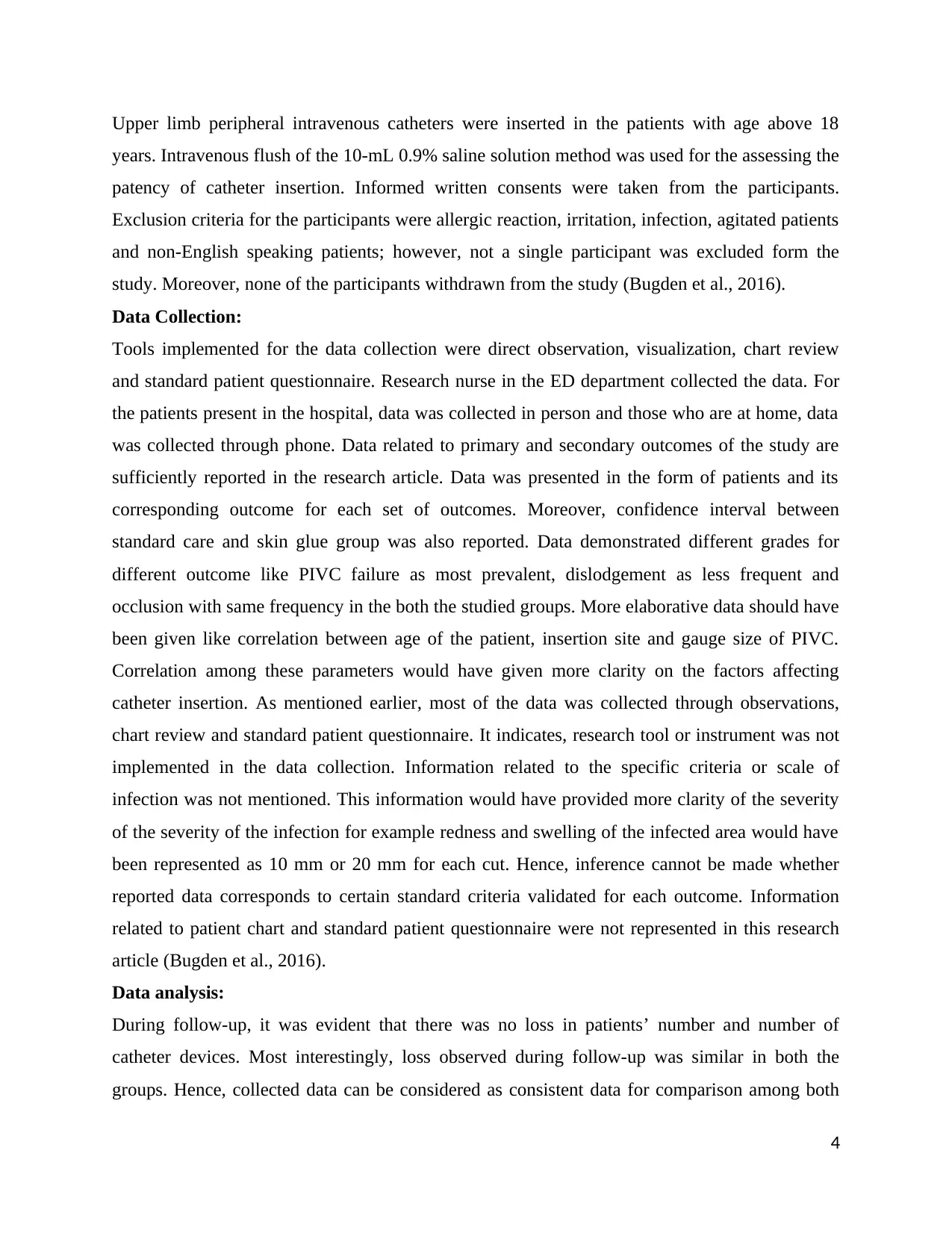
Upper limb peripheral intravenous catheters were inserted in the patients with age above 18
years. Intravenous flush of the 10-mL 0.9% saline solution method was used for the assessing the
patency of catheter insertion. Informed written consents were taken from the participants.
Exclusion criteria for the participants were allergic reaction, irritation, infection, agitated patients
and non-English speaking patients; however, not a single participant was excluded form the
study. Moreover, none of the participants withdrawn from the study (Bugden et al., 2016).
Data Collection:
Tools implemented for the data collection were direct observation, visualization, chart review
and standard patient questionnaire. Research nurse in the ED department collected the data. For
the patients present in the hospital, data was collected in person and those who are at home, data
was collected through phone. Data related to primary and secondary outcomes of the study are
sufficiently reported in the research article. Data was presented in the form of patients and its
corresponding outcome for each set of outcomes. Moreover, confidence interval between
standard care and skin glue group was also reported. Data demonstrated different grades for
different outcome like PIVC failure as most prevalent, dislodgement as less frequent and
occlusion with same frequency in the both the studied groups. More elaborative data should have
been given like correlation between age of the patient, insertion site and gauge size of PIVC.
Correlation among these parameters would have given more clarity on the factors affecting
catheter insertion. As mentioned earlier, most of the data was collected through observations,
chart review and standard patient questionnaire. It indicates, research tool or instrument was not
implemented in the data collection. Information related to the specific criteria or scale of
infection was not mentioned. This information would have provided more clarity of the severity
of the severity of the infection for example redness and swelling of the infected area would have
been represented as 10 mm or 20 mm for each cut. Hence, inference cannot be made whether
reported data corresponds to certain standard criteria validated for each outcome. Information
related to patient chart and standard patient questionnaire were not represented in this research
article (Bugden et al., 2016).
Data analysis:
During follow-up, it was evident that there was no loss in patients’ number and number of
catheter devices. Most interestingly, loss observed during follow-up was similar in both the
groups. Hence, collected data can be considered as consistent data for comparison among both
4
years. Intravenous flush of the 10-mL 0.9% saline solution method was used for the assessing the
patency of catheter insertion. Informed written consents were taken from the participants.
Exclusion criteria for the participants were allergic reaction, irritation, infection, agitated patients
and non-English speaking patients; however, not a single participant was excluded form the
study. Moreover, none of the participants withdrawn from the study (Bugden et al., 2016).
Data Collection:
Tools implemented for the data collection were direct observation, visualization, chart review
and standard patient questionnaire. Research nurse in the ED department collected the data. For
the patients present in the hospital, data was collected in person and those who are at home, data
was collected through phone. Data related to primary and secondary outcomes of the study are
sufficiently reported in the research article. Data was presented in the form of patients and its
corresponding outcome for each set of outcomes. Moreover, confidence interval between
standard care and skin glue group was also reported. Data demonstrated different grades for
different outcome like PIVC failure as most prevalent, dislodgement as less frequent and
occlusion with same frequency in the both the studied groups. More elaborative data should have
been given like correlation between age of the patient, insertion site and gauge size of PIVC.
Correlation among these parameters would have given more clarity on the factors affecting
catheter insertion. As mentioned earlier, most of the data was collected through observations,
chart review and standard patient questionnaire. It indicates, research tool or instrument was not
implemented in the data collection. Information related to the specific criteria or scale of
infection was not mentioned. This information would have provided more clarity of the severity
of the severity of the infection for example redness and swelling of the infected area would have
been represented as 10 mm or 20 mm for each cut. Hence, inference cannot be made whether
reported data corresponds to certain standard criteria validated for each outcome. Information
related to patient chart and standard patient questionnaire were not represented in this research
article (Bugden et al., 2016).
Data analysis:
During follow-up, it was evident that there was no loss in patients’ number and number of
catheter devices. Most interestingly, loss observed during follow-up was similar in both the
groups. Hence, collected data can be considered as consistent data for comparison among both
4
Paraphrase This Document
Need a fresh take? Get an instant paraphrase of this document with our AI Paraphraser
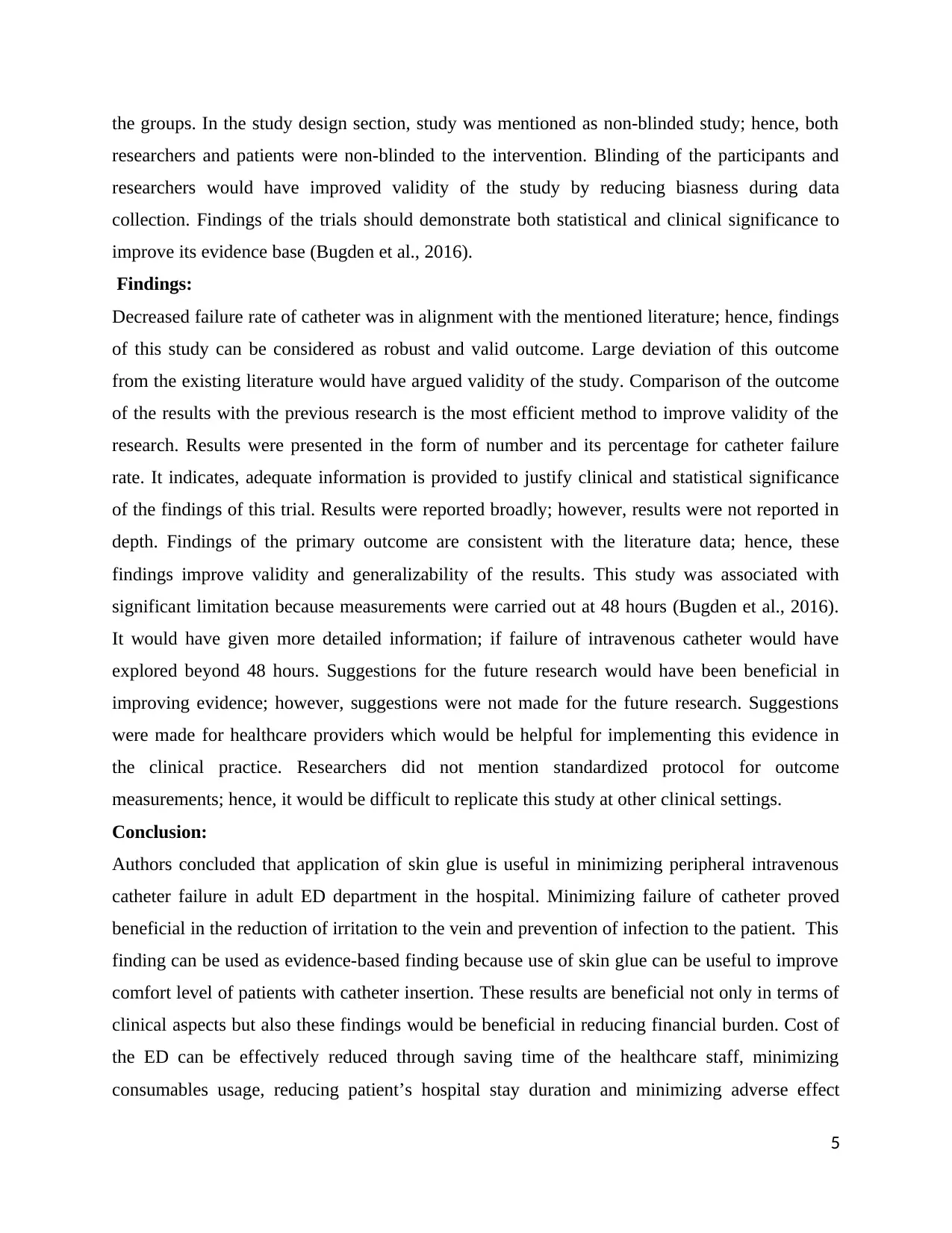
the groups. In the study design section, study was mentioned as non-blinded study; hence, both
researchers and patients were non-blinded to the intervention. Blinding of the participants and
researchers would have improved validity of the study by reducing biasness during data
collection. Findings of the trials should demonstrate both statistical and clinical significance to
improve its evidence base (Bugden et al., 2016).
Findings:
Decreased failure rate of catheter was in alignment with the mentioned literature; hence, findings
of this study can be considered as robust and valid outcome. Large deviation of this outcome
from the existing literature would have argued validity of the study. Comparison of the outcome
of the results with the previous research is the most efficient method to improve validity of the
research. Results were presented in the form of number and its percentage for catheter failure
rate. It indicates, adequate information is provided to justify clinical and statistical significance
of the findings of this trial. Results were reported broadly; however, results were not reported in
depth. Findings of the primary outcome are consistent with the literature data; hence, these
findings improve validity and generalizability of the results. This study was associated with
significant limitation because measurements were carried out at 48 hours (Bugden et al., 2016).
It would have given more detailed information; if failure of intravenous catheter would have
explored beyond 48 hours. Suggestions for the future research would have been beneficial in
improving evidence; however, suggestions were not made for the future research. Suggestions
were made for healthcare providers which would be helpful for implementing this evidence in
the clinical practice. Researchers did not mention standardized protocol for outcome
measurements; hence, it would be difficult to replicate this study at other clinical settings.
Conclusion:
Authors concluded that application of skin glue is useful in minimizing peripheral intravenous
catheter failure in adult ED department in the hospital. Minimizing failure of catheter proved
beneficial in the reduction of irritation to the vein and prevention of infection to the patient. This
finding can be used as evidence-based finding because use of skin glue can be useful to improve
comfort level of patients with catheter insertion. These results are beneficial not only in terms of
clinical aspects but also these findings would be beneficial in reducing financial burden. Cost of
the ED can be effectively reduced through saving time of the healthcare staff, minimizing
consumables usage, reducing patient’s hospital stay duration and minimizing adverse effect
5
researchers and patients were non-blinded to the intervention. Blinding of the participants and
researchers would have improved validity of the study by reducing biasness during data
collection. Findings of the trials should demonstrate both statistical and clinical significance to
improve its evidence base (Bugden et al., 2016).
Findings:
Decreased failure rate of catheter was in alignment with the mentioned literature; hence, findings
of this study can be considered as robust and valid outcome. Large deviation of this outcome
from the existing literature would have argued validity of the study. Comparison of the outcome
of the results with the previous research is the most efficient method to improve validity of the
research. Results were presented in the form of number and its percentage for catheter failure
rate. It indicates, adequate information is provided to justify clinical and statistical significance
of the findings of this trial. Results were reported broadly; however, results were not reported in
depth. Findings of the primary outcome are consistent with the literature data; hence, these
findings improve validity and generalizability of the results. This study was associated with
significant limitation because measurements were carried out at 48 hours (Bugden et al., 2016).
It would have given more detailed information; if failure of intravenous catheter would have
explored beyond 48 hours. Suggestions for the future research would have been beneficial in
improving evidence; however, suggestions were not made for the future research. Suggestions
were made for healthcare providers which would be helpful for implementing this evidence in
the clinical practice. Researchers did not mention standardized protocol for outcome
measurements; hence, it would be difficult to replicate this study at other clinical settings.
Conclusion:
Authors concluded that application of skin glue is useful in minimizing peripheral intravenous
catheter failure in adult ED department in the hospital. Minimizing failure of catheter proved
beneficial in the reduction of irritation to the vein and prevention of infection to the patient. This
finding can be used as evidence-based finding because use of skin glue can be useful to improve
comfort level of patients with catheter insertion. These results are beneficial not only in terms of
clinical aspects but also these findings would be beneficial in reducing financial burden. Cost of
the ED can be effectively reduced through saving time of the healthcare staff, minimizing
consumables usage, reducing patient’s hospital stay duration and minimizing adverse effect
5
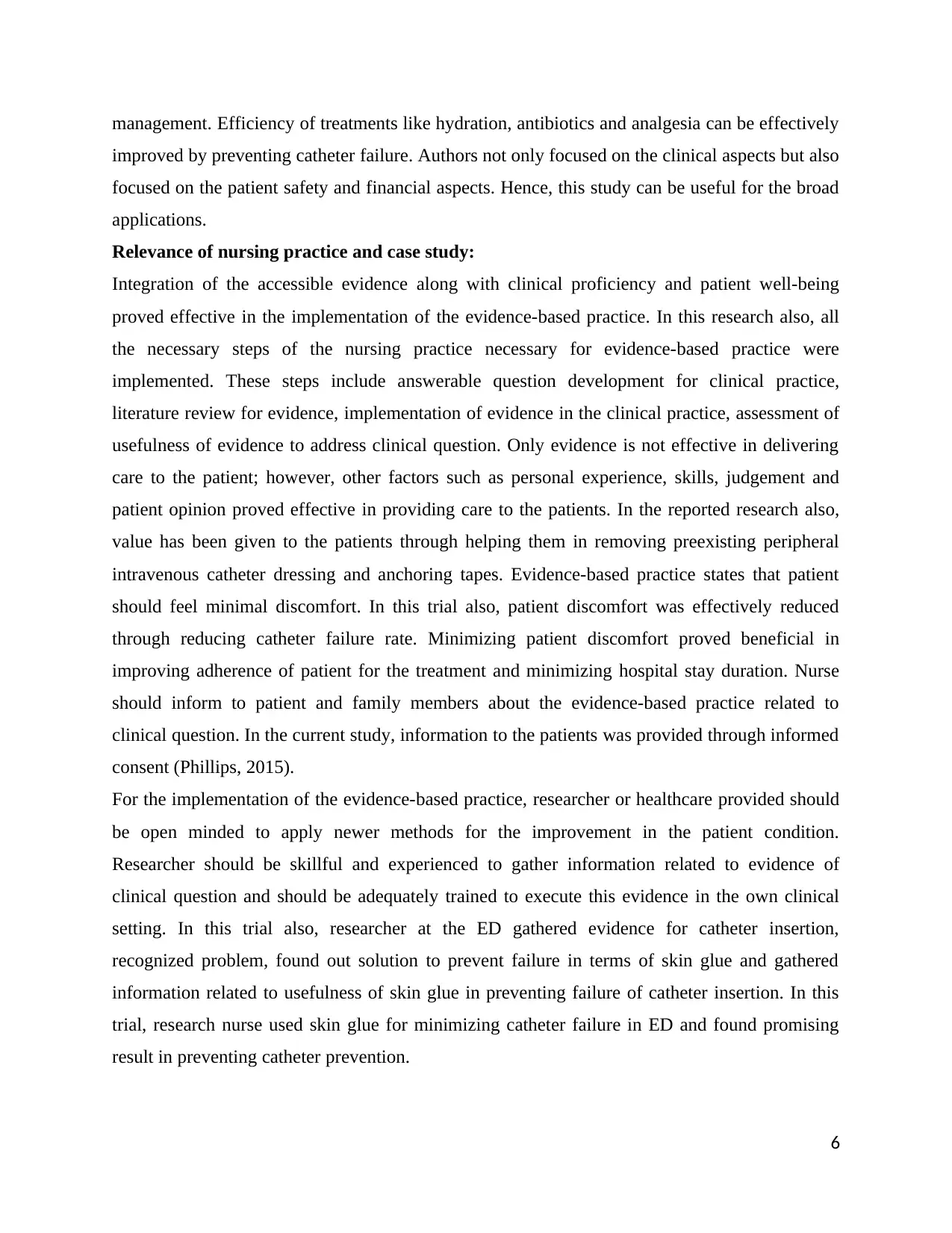
management. Efficiency of treatments like hydration, antibiotics and analgesia can be effectively
improved by preventing catheter failure. Authors not only focused on the clinical aspects but also
focused on the patient safety and financial aspects. Hence, this study can be useful for the broad
applications.
Relevance of nursing practice and case study:
Integration of the accessible evidence along with clinical proficiency and patient well-being
proved effective in the implementation of the evidence-based practice. In this research also, all
the necessary steps of the nursing practice necessary for evidence-based practice were
implemented. These steps include answerable question development for clinical practice,
literature review for evidence, implementation of evidence in the clinical practice, assessment of
usefulness of evidence to address clinical question. Only evidence is not effective in delivering
care to the patient; however, other factors such as personal experience, skills, judgement and
patient opinion proved effective in providing care to the patients. In the reported research also,
value has been given to the patients through helping them in removing preexisting peripheral
intravenous catheter dressing and anchoring tapes. Evidence-based practice states that patient
should feel minimal discomfort. In this trial also, patient discomfort was effectively reduced
through reducing catheter failure rate. Minimizing patient discomfort proved beneficial in
improving adherence of patient for the treatment and minimizing hospital stay duration. Nurse
should inform to patient and family members about the evidence-based practice related to
clinical question. In the current study, information to the patients was provided through informed
consent (Phillips, 2015).
For the implementation of the evidence-based practice, researcher or healthcare provided should
be open minded to apply newer methods for the improvement in the patient condition.
Researcher should be skillful and experienced to gather information related to evidence of
clinical question and should be adequately trained to execute this evidence in the own clinical
setting. In this trial also, researcher at the ED gathered evidence for catheter insertion,
recognized problem, found out solution to prevent failure in terms of skin glue and gathered
information related to usefulness of skin glue in preventing failure of catheter insertion. In this
trial, research nurse used skin glue for minimizing catheter failure in ED and found promising
result in preventing catheter prevention.
6
improved by preventing catheter failure. Authors not only focused on the clinical aspects but also
focused on the patient safety and financial aspects. Hence, this study can be useful for the broad
applications.
Relevance of nursing practice and case study:
Integration of the accessible evidence along with clinical proficiency and patient well-being
proved effective in the implementation of the evidence-based practice. In this research also, all
the necessary steps of the nursing practice necessary for evidence-based practice were
implemented. These steps include answerable question development for clinical practice,
literature review for evidence, implementation of evidence in the clinical practice, assessment of
usefulness of evidence to address clinical question. Only evidence is not effective in delivering
care to the patient; however, other factors such as personal experience, skills, judgement and
patient opinion proved effective in providing care to the patients. In the reported research also,
value has been given to the patients through helping them in removing preexisting peripheral
intravenous catheter dressing and anchoring tapes. Evidence-based practice states that patient
should feel minimal discomfort. In this trial also, patient discomfort was effectively reduced
through reducing catheter failure rate. Minimizing patient discomfort proved beneficial in
improving adherence of patient for the treatment and minimizing hospital stay duration. Nurse
should inform to patient and family members about the evidence-based practice related to
clinical question. In the current study, information to the patients was provided through informed
consent (Phillips, 2015).
For the implementation of the evidence-based practice, researcher or healthcare provided should
be open minded to apply newer methods for the improvement in the patient condition.
Researcher should be skillful and experienced to gather information related to evidence of
clinical question and should be adequately trained to execute this evidence in the own clinical
setting. In this trial also, researcher at the ED gathered evidence for catheter insertion,
recognized problem, found out solution to prevent failure in terms of skin glue and gathered
information related to usefulness of skin glue in preventing failure of catheter insertion. In this
trial, research nurse used skin glue for minimizing catheter failure in ED and found promising
result in preventing catheter prevention.
6
⊘ This is a preview!⊘
Do you want full access?
Subscribe today to unlock all pages.

Trusted by 1+ million students worldwide
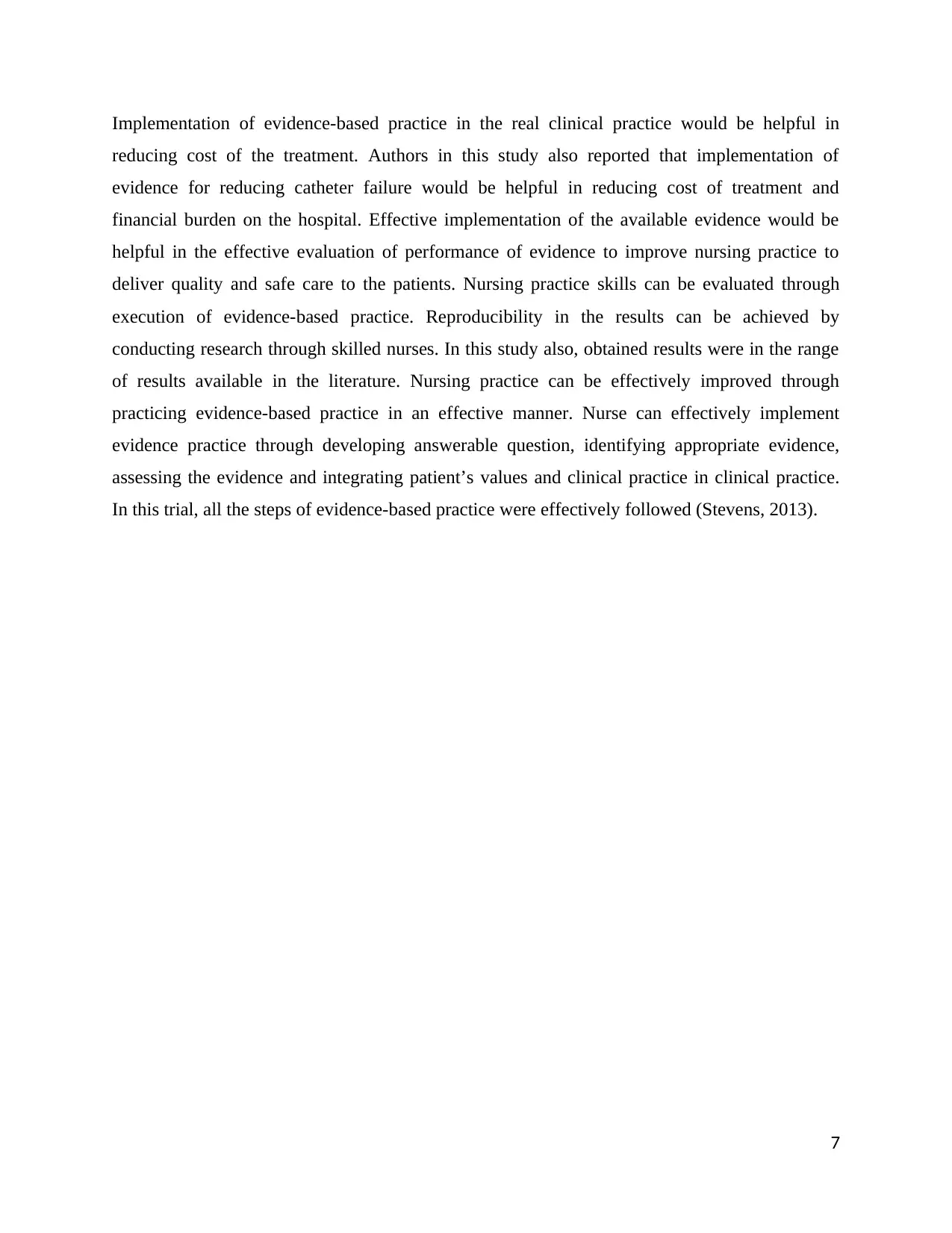
Implementation of evidence-based practice in the real clinical practice would be helpful in
reducing cost of the treatment. Authors in this study also reported that implementation of
evidence for reducing catheter failure would be helpful in reducing cost of treatment and
financial burden on the hospital. Effective implementation of the available evidence would be
helpful in the effective evaluation of performance of evidence to improve nursing practice to
deliver quality and safe care to the patients. Nursing practice skills can be evaluated through
execution of evidence-based practice. Reproducibility in the results can be achieved by
conducting research through skilled nurses. In this study also, obtained results were in the range
of results available in the literature. Nursing practice can be effectively improved through
practicing evidence-based practice in an effective manner. Nurse can effectively implement
evidence practice through developing answerable question, identifying appropriate evidence,
assessing the evidence and integrating patient’s values and clinical practice in clinical practice.
In this trial, all the steps of evidence-based practice were effectively followed (Stevens, 2013).
7
reducing cost of the treatment. Authors in this study also reported that implementation of
evidence for reducing catheter failure would be helpful in reducing cost of treatment and
financial burden on the hospital. Effective implementation of the available evidence would be
helpful in the effective evaluation of performance of evidence to improve nursing practice to
deliver quality and safe care to the patients. Nursing practice skills can be evaluated through
execution of evidence-based practice. Reproducibility in the results can be achieved by
conducting research through skilled nurses. In this study also, obtained results were in the range
of results available in the literature. Nursing practice can be effectively improved through
practicing evidence-based practice in an effective manner. Nurse can effectively implement
evidence practice through developing answerable question, identifying appropriate evidence,
assessing the evidence and integrating patient’s values and clinical practice in clinical practice.
In this trial, all the steps of evidence-based practice were effectively followed (Stevens, 2013).
7
Paraphrase This Document
Need a fresh take? Get an instant paraphrase of this document with our AI Paraphraser
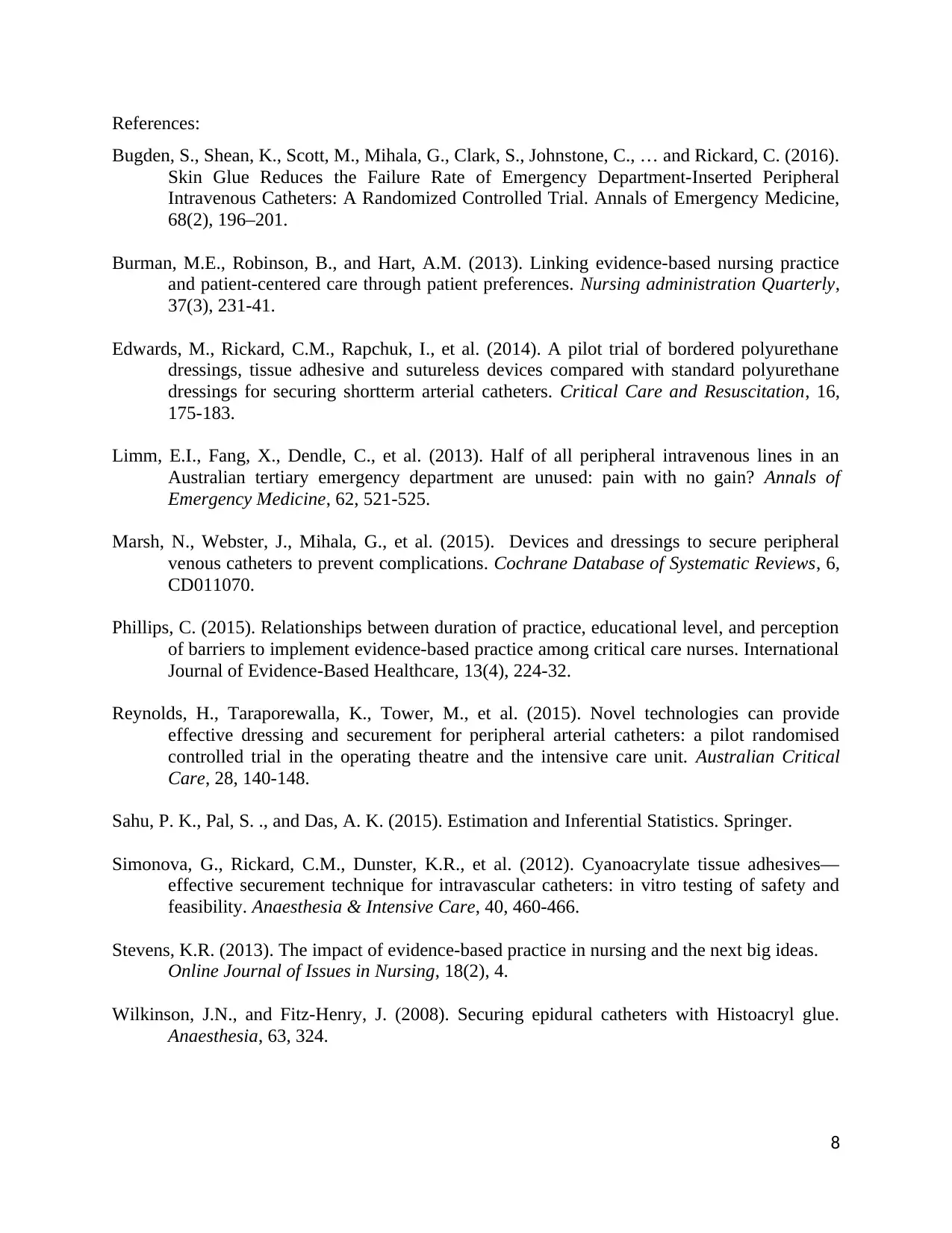
References:
Bugden, S., Shean, K., Scott, M., Mihala, G., Clark, S., Johnstone, C., … and Rickard, C. (2016).
Skin Glue Reduces the Failure Rate of Emergency Department-Inserted Peripheral
Intravenous Catheters: A Randomized Controlled Trial. Annals of Emergency Medicine,
68(2), 196–201.
Burman, M.E., Robinson, B., and Hart, A.M. (2013). Linking evidence-based nursing practice
and patient-centered care through patient preferences. Nursing administration Quarterly,
37(3), 231-41.
Edwards, M., Rickard, C.M., Rapchuk, I., et al. (2014). A pilot trial of bordered polyurethane
dressings, tissue adhesive and sutureless devices compared with standard polyurethane
dressings for securing shortterm arterial catheters. Critical Care and Resuscitation, 16,
175-183.
Limm, E.I., Fang, X., Dendle, C., et al. (2013). Half of all peripheral intravenous lines in an
Australian tertiary emergency department are unused: pain with no gain? Annals of
Emergency Medicine, 62, 521-525.
Marsh, N., Webster, J., Mihala, G., et al. (2015). Devices and dressings to secure peripheral
venous catheters to prevent complications. Cochrane Database of Systematic Reviews, 6,
CD011070.
Phillips, C. (2015). Relationships between duration of practice, educational level, and perception
of barriers to implement evidence-based practice among critical care nurses. International
Journal of Evidence-Based Healthcare, 13(4), 224-32.
Reynolds, H., Taraporewalla, K., Tower, M., et al. (2015). Novel technologies can provide
effective dressing and securement for peripheral arterial catheters: a pilot randomised
controlled trial in the operating theatre and the intensive care unit. Australian Critical
Care, 28, 140-148.
Sahu, P. K., Pal, S. ., and Das, A. K. (2015). Estimation and Inferential Statistics. Springer.
Simonova, G., Rickard, C.M., Dunster, K.R., et al. (2012). Cyanoacrylate tissue adhesives—
effective securement technique for intravascular catheters: in vitro testing of safety and
feasibility. Anaesthesia & Intensive Care, 40, 460-466.
Stevens, K.R. (2013). The impact of evidence-based practice in nursing and the next big ideas.
Online Journal of Issues in Nursing, 18(2), 4.
Wilkinson, J.N., and Fitz-Henry, J. (2008). Securing epidural catheters with Histoacryl glue.
Anaesthesia, 63, 324.
8
Bugden, S., Shean, K., Scott, M., Mihala, G., Clark, S., Johnstone, C., … and Rickard, C. (2016).
Skin Glue Reduces the Failure Rate of Emergency Department-Inserted Peripheral
Intravenous Catheters: A Randomized Controlled Trial. Annals of Emergency Medicine,
68(2), 196–201.
Burman, M.E., Robinson, B., and Hart, A.M. (2013). Linking evidence-based nursing practice
and patient-centered care through patient preferences. Nursing administration Quarterly,
37(3), 231-41.
Edwards, M., Rickard, C.M., Rapchuk, I., et al. (2014). A pilot trial of bordered polyurethane
dressings, tissue adhesive and sutureless devices compared with standard polyurethane
dressings for securing shortterm arterial catheters. Critical Care and Resuscitation, 16,
175-183.
Limm, E.I., Fang, X., Dendle, C., et al. (2013). Half of all peripheral intravenous lines in an
Australian tertiary emergency department are unused: pain with no gain? Annals of
Emergency Medicine, 62, 521-525.
Marsh, N., Webster, J., Mihala, G., et al. (2015). Devices and dressings to secure peripheral
venous catheters to prevent complications. Cochrane Database of Systematic Reviews, 6,
CD011070.
Phillips, C. (2015). Relationships between duration of practice, educational level, and perception
of barriers to implement evidence-based practice among critical care nurses. International
Journal of Evidence-Based Healthcare, 13(4), 224-32.
Reynolds, H., Taraporewalla, K., Tower, M., et al. (2015). Novel technologies can provide
effective dressing and securement for peripheral arterial catheters: a pilot randomised
controlled trial in the operating theatre and the intensive care unit. Australian Critical
Care, 28, 140-148.
Sahu, P. K., Pal, S. ., and Das, A. K. (2015). Estimation and Inferential Statistics. Springer.
Simonova, G., Rickard, C.M., Dunster, K.R., et al. (2012). Cyanoacrylate tissue adhesives—
effective securement technique for intravascular catheters: in vitro testing of safety and
feasibility. Anaesthesia & Intensive Care, 40, 460-466.
Stevens, K.R. (2013). The impact of evidence-based practice in nursing and the next big ideas.
Online Journal of Issues in Nursing, 18(2), 4.
Wilkinson, J.N., and Fitz-Henry, J. (2008). Securing epidural catheters with Histoacryl glue.
Anaesthesia, 63, 324.
8
1 out of 8
Related Documents
Your All-in-One AI-Powered Toolkit for Academic Success.
+13062052269
info@desklib.com
Available 24*7 on WhatsApp / Email
![[object Object]](/_next/static/media/star-bottom.7253800d.svg)
Unlock your academic potential
Copyright © 2020–2025 A2Z Services. All Rights Reserved. Developed and managed by ZUCOL.





